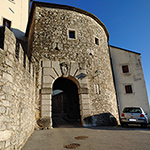
Fabiani path runs between Štanjel and Kobdilj, it unites several shorter walking trails, leading to favorite works of architectural creations of Max Fabiani. Max Fabiani is a known architect, who in Štanjel worked during the First and Second World War.
Fabiani path starts below the old part of Štanjel, the path on the leads towards entrance tower, but Fabiani path starts on the left with iron doors with inscription Dotte Fmed 19XIII35. From here the path takes us between pine trees on arranged macadam path approximately 20 meters below castle walls towards Ferrari garden. Along the path, a beautiful view opens towards Vipava valley and lower to Branica valley.

The path takes us to Ferrari garden through pavilion with a square floor plan, in the garden is a small artificial lake with a small island and Venetian bridge. The path, which takes us through Štanjel, will take us around half an hour. You can extend your walk up to Fabiani birth village Kobdilj, which will take you about an hour. Along the path you will see Fabiani benches, it takes us to pass cemetery of St. Gregory, which is located on an elevation between Štanjel and Kobdilj.
In the upper part of Kobdilj is Fabiani’s homestead with the famous mulberry, you can also descent towards the lower part of the village and see numerous famous kitchen extensions with open-hearth (si. Spahnjenca) and the central market of Kobdilj. From here the path continues towards the railway, which is part of Bled railway, along which we descent towards grassy Karst valley, where the Austria-Hungary military cemetery is located. Pass railway tunnel back to Štanjel.
|
|
|
 Štanjel
Štanjel
Štanjel is located on the northeastern edge of Karst plateau, it is combined by old part or Gornja vas, which is located on the slope of Turn and newer part or Dolnja vas. It is one of the oldest settlements on Karst, it was written for its old city center. It got its name after the patron of the church, St. Danijel. [_Read more_]
 Ferrari garden
Ferrari garden
Ferrari garden or garden park in Štanjel has a special meaning for Slovenia, because of its cultural, art architectural and other outstanding properties. It is located below the village wall, designed by architect Max Fabiani in the time of his mayoralty. The estate was owned by Trieste doctor Enrico Ferrari. [_Read more_]
 Villa Ferrari
Villa Ferrari
Villa Ferrari is a joint name for a set of houses in the eastern part of Štanjel, arranged by Fabiani for his brother-in-law Enrico Ferrari. Since the year 1920, Enrico Ferrari bought most of the houses in the complex between the tower of Štanjel wall and few more houses in another complex. [_Read more_]
 Tower of Kobdilj
Tower of Kobdilj
Tower of Kobdilj door is located on the other side of the settlement Štanjel and belongs into the complex of villa Ferrari. The tower once protected the entrance to the settlement from Vipava valley. The tower was in the 1930s changed into dining room and a beautiful terrace by Max Fabiani. [_Read more_]
 Lookout point or Gledanica
Lookout point or Gledanica
Lookout point, Slovenian Gledanica, is located on the top of Štanjel hump or Turn, which separates Karst plateau from Vipava valley. Because of its geographical location, it was an important strategic observational and control point. On the top an exceptional view to all sides opens. [_Read more_]
 Church of St. Daniel
Church of St. Daniel
Parish church of St. Daniel is located in the old part of Štanjel, in Gornja vas, and it is visible immediately upon entering through the castle door. The church was built between the years 1455 and 1460 in the place of an older building. It represents one of the key monuments of Gothic architecture on Karst. [_Read more_]
 Church of St. Gregory
Church of St. Gregory
The church of St. Gregory is located on a smaller elevation above Kobdilj and is decorated with a Gothic portal and the bell tower on equisetum or bellflower. It stands in the middle of the walled cemetery. It is the late Gothic church, which was built between the years 1463 and 1464. [_Read more_]
 Military cemetery from WWI
Military cemetery from WWI
The Austria-Hungary military cemetery is located in a small valley below Štanjel. Austria-Hungary solders and Russian prisoners are buried here, who died in nearby hospital in Štanjel castle and in auxiliary hospital buildings in vicinity. At the entrance are two stone columns with the years 1915 and 1917. [_Read more_]
 Entrance tower
Entrance tower
The entrance tower or the main entrance is fortified part of the Štanjel settlement, which once was part of a defense wall. During the mayoral period, Max Fabiani restored the entrance. He expended the entrance with cement inserts. The Cobenzl family coat of arms is also on the tower. [_Read more_]







